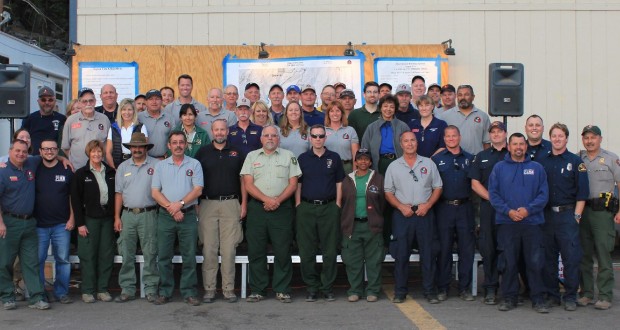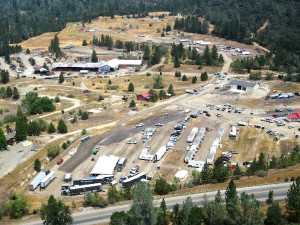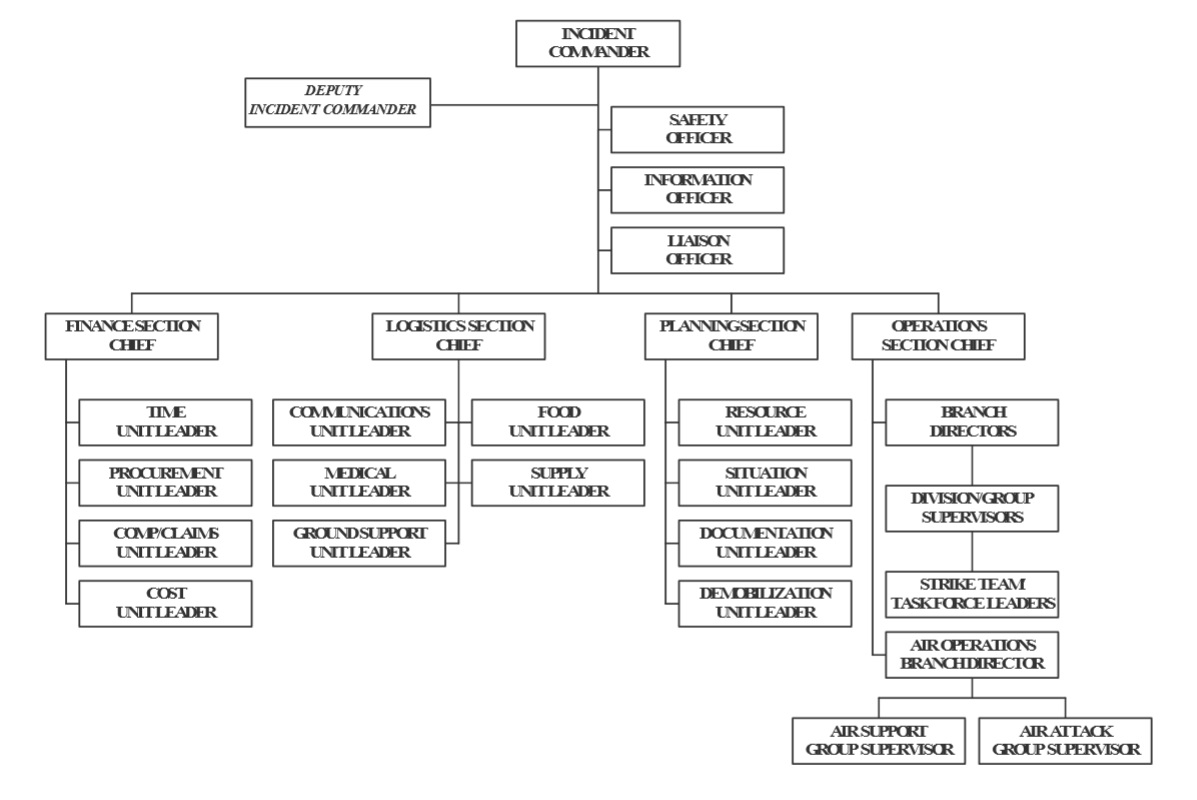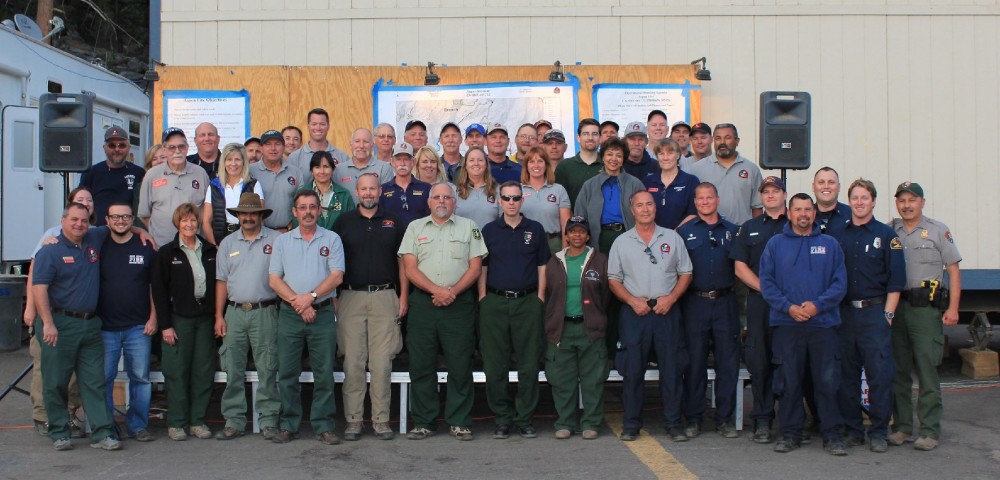NORTH FORK – As the Willow Fire has played out over the past eight days, and residents have watched in alarm as huge plumes of smoke rise over Peckinpah Mountain, people may have wondered just who’s running this show.
Well, that would be a group of calm, methodical, deliberate individuals who make up the South Central Sierra Interagency Incident Management Team. Together, they bring countless years of experience to the business of battling large wildfires, and they are apparently very good at it.
To introduce you to the people and the process, let’s take a trip back to last year’s French Fire, almost exactly one year ago, because the events are quite similar, and and the town looks just the same…
SIERRA NATIONAL FOREST – Just before 6 a.m. on Monday, July 28, the lookout on Shuteye Peak spotted a column of smoke rising from the area of Rock Creek Campground. Sierra Dispatch was notified and a call placed to Mark Smith, the day’s Duty Officer on the Bass Lake Ranger District. Smith made the trip from his home to the site of the fire in record time, and found 25-30 acres of forest already burning.
By the next evening, a small city had sprung up at the Old Mill Site in North Fork. Trailers and portable office units had been set up in neat rows, a full service kitchen was on line, and helicopters and their support units had taken up residence at the newly established heliport.
So how does all that happen, and what system is in place to get such a large project done in such a short amount of time?
To learn the answers, I sat down with the man in charge of every detail on the French Fire, Incident Commander (IC) David Cooper.
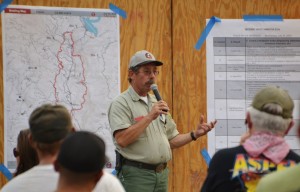
David Cooper Incident Commander on the recent Willow Fire, the Sky Fire and last year’s French Fire.
Cooper is a home-grown boy who started camping along the Sierra Vista Scenic Byway, now ravaged by the French Fire, when he was just five years old. After 26 years on the High Sierra Ranger District, rising through the ranks to Battalion Chief and Assistant Fire Management Officer (FMO), Cooper has been the FMO on the Bass Lake Ranger District in North Fork for the past seven years.
For five of those years, he has also been in charge of the South Central Sierra Interagency Incident Management Team (SCSIIMT), the group brought in to manage operations on the French Fire.
Interagency Incident Management Teams (IIMTs) are called up when fires grow too large or complex for local agencies to handle. It became clear very early on that the French Fire was going to be a significant event, and David Cooper and his team got the call by 9 a.m. the day of the fire. They mobilized immediately and got to work.
Interagency Incident Management Teams are made up of people who have applied for these positions and serve for three years. They are called up from their regular jobs when an incident requires their services, and come from a wide variety of federal, state, county and local agencies. The SCSIIMT is comprised of 56 individuals from the US Forest Service, the National Park Service, the Bureau of Land Management, Fish and Wildlife, Kern County Fire Department, Mariposa County, Stanislaus County, the city of Bakersfield and other agencies. Twelve of their number are trainees, which helps in planning for successors to fill the positions vacated by current team members.
There are five levels of IIMTs. The SCSIIMT is a Type 2 team. The size and complexity of a fire determines what type of team is needed, and each has a different level of training and qualifications. Very large incidents such as last year’s Rim Fire, are managed by Type 1 teams, though the SCSIIMT was the first team on the Rim Fire, and when the Type 1 team was released, the SCSIIMT returned to finish out the process.
Every few days a complexity and risk analysis is done to evaluate the activity on the fire and determine whether things warrant pushing the management up to the next level.
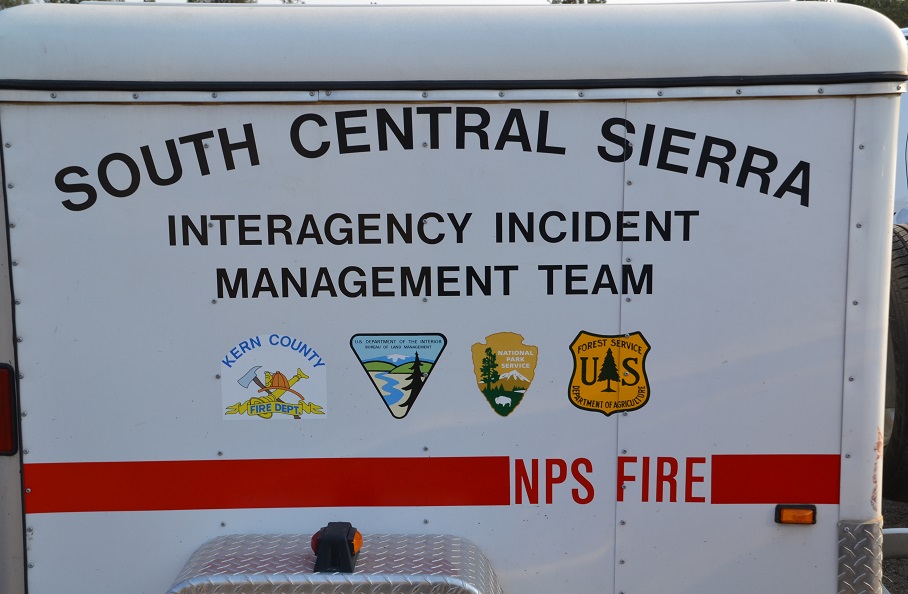
The SCSIIMT comes equipped with what they need to get the job done.
When Cooper and his team were called up for the French Fire, everyone headed for North Fork and by 6 p.m. were meeting with Bass Lake District Ranger Dave Martin and Type 3 Incident Commander Mark Smith, getting a briefing on what was happening on the fire, and learning what the expectations were from the Agency Administrator, which is the local Ranger District.
They then conducted an official transfer of command, delegating authority from the local district to the SCSIIMT to manage the fire, and the team set to work.
They ordered up trailers and portable toilets, contractors for laundry service, printing and food service. They needed sleeping and showering accommodations, meeting tents and medical services, a communications center and a heliport. But first things first – and that means taking care of the boots on the ground. Local forest patrol and SCSIIMT Food Unit Manager Jose Sanchez ordered up a few hundred sandwiches from Gas ‘n Stuff to take care of the firefighters already on the line. This whole organization is, first and foremost, about taking care of those people on the firelines.
With so many details inherent in the process, how does everyone work together with such speed and efficiency?
They follow an Incident Command System (ICS) developed nearly 30 years ago for managing emergency incidents when diverse agencies are working together in high-pressure situations. The ICS ensures that everyone is working within the same organizational structure, using the same terminology, following a standardized radio protocol, and understands the incident objectives. In short, everyone from all these different agencies is on the same page. Whether it’s a wildfire, the 911 attacks or Hurricane Katrina, these teams are able to work together in a very efficient manner due to the ICS structure.
So everyone knows what their job is, and they get busy setting up what will become known as “French Town” at the Old Mill Site. Within 24 hours, the new town is ready to conduct business and resources are arriving day and night.
All along the “Main Street” of this little town are the offices of the Command Staff and the General Staff. Cooper’s Command Staff is made up of an Information Officer, two Liaison Officers and two Safety Officers. These folks are responsible for the release of information to the public and the news media, making sure all the various agencies are communicating well with each other, and assuring the safety of all personnel on the incident.
Cooper also has a Deputy who has the same training and qualifications as the IC and is ready to step into that position should the need arise.
The General Staff consists of four Section Chiefs, who supervise various Unit Leaders:
The Operations Section Chief is the direct supervisor for most personnel on the incident. He supervises all Operations Branch/Division/Group and Air Operations personnel, develops the operations portion of the twice-daily Incident Action Plan (IAP), requests resources to support tactical operations, and ensures that everything is implemented in a safe manner.
The Planning Section Chief supervises the units responsible for tracking personnel and resources, mapping the incident, maintaining documents, and demobilizing when the troops head home. One very important job here is putting together the Incident Action Plan that is distributed twice a day at a briefing for the next shift headed out to the fireline. The IAP details anticipated fire behavior and weather conditions, personnel and equipment assignments across the different sections of the fire, safety concerns, air operations and radio frequencies.
The Logistics Section Chief is responsible for everything needed to keep both support staff and firefighters fed and outfitted, with the exception of the aircraft. His units order and receive supplies, set up the facilities, maintain the vehicles and communication systems, and manage the food and medical units.
The Finance/Administration Section Chief handles personnel time records, keeps track of contractor agreements, deals with injury and property claims, and supervises all financial aspects of an incident. (click images for details)
(Source – http://www.fs.usda.gov/detail/r5/fire-aviation/incidentinformation/?cid=stelprdb5303205)
Twice a day, the IC sits down with his Section Chiefs and they determine what will be needed for the next shift. However, throughout the day they’re all in communication with each other, discussing what their needs are and where they’re headed.
“We have a planning meeting at 10 a.m. for night shift, and again at 8 p.m. for the next day shift,” says IC Cooper. “In between those meetings, Operations and Logistics have been working together. Operations is kind of the driving force. They’re looking at the ground, knowing where they need to go, how many people they need to do it, and what kind of equipment will be required. They’re working with Logistics to provide all the equipment and supplies, and they’re talking to Planning to put it all together. That way when they go in to the meeting, they’ve already got a rough plan put together. Then it’s just association with everybody else to say, okay, can you meet that, do you have any issues or are you good to go? Do you support the plan?”
One example of a logistical and planning challenge on the French Fire was the spike camp at Minarets Work Station, meant to support some 300 firefighters. After delivering plenty of water and Gatorade, they needed portable toilets and facilities, sleeping arrangements, manpower to set everything up and the food unit to deliver whatever meals would be needed. And that’s the short list. In this instance, they had been ready to go, but the very active fire behavior that prompted the evacuation of Arnold Meadow at the end of last week, delayed implementing the plan. Keeping firefighters and the public safe is always the number one priority, and conditions on the ground change rapidly and constantly.
The Agency Administrator – in this case the Bass Lake Ranger District – also hears the plan, along with cooperators such as Southern California Edison and Cal Fire. The are kept in the loop by the Liaisons and can voice their concerns and express any issues they may have, so these can be addressed and worked out. In the end, the buck stops with the IC, and he has the final say.
As the fire is contained, lines are fortified and fire activity dies down, the Team will demobilize the troops and deconstruct French Town in the same efficient way with which they put it up. Contractors will be released, crews sent off to be reassigned to other fires, and the Old Mill Site will be returned to its pre-fire condition. The Team will work with the CDC, the Madera County Fire Department and the North Fork Rancheria of Mono Indians, whose facilities are right in the middle of the action, to ensure that whatever is needed is done to hand the property back to the owners in the condition in which it was received, if not a bit better with the grading improvements.
As this is going on, repairs and improvements to the fire area itself will begin, as crews build water bars, pull berms back onto the firelines, return brush and debris to those trails, and install barriers to discourage future use as Jeep or OHV trails.
A Burned Area Emergency Response (BAER) Team will soon be sent into the area to assess the damage and formulate their plan to prevent further damage to life, property or natural resources.
Then all the members of the SCSIIMT will return to their “day jobs,” where all their work will surely be waiting for them, and hope for a good long break before their very specialized services are needed again.
As for David Cooper, this is his last year on his second three-year term as IC on this team. He may step aside and let someone else take the reins, and he may decide to step up to a Type 1 team, a position for which he has been training. Either way, it’s a job he enjoys, and his “home team” is fighting for their hometown forest.
California Interagency Incident Management Teams respond to emergencies all across the United States. In 2001, one California team was sent to the World Trade Center disaster and another to the Pentagon. The SCSIIMT spent 26 days on Hurricane Katrina in 2006. This is their third large fire in California this year.
Meet the South Central Sierra Interagency Incident Management Team. Visit them on Facebook.

